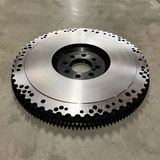Exhaust Pipe: Which Material Should You Choose? [+extra information]

Information about different materials in exhaust systems / exhaust pipes.
- 304
- 304L
- 316L
- 321L
- Extra information
Low carbon content results in lower carbide precipitation during welding, which means that the material at the welds is more resistant to corrosion / erosion / discoloration. The difference is small between 304 and 304L.
1 ▼
304
Commonly affordable stainless steel.
Stainless material commonly referred to as 304 is actually 18/8 steel (AISI 304/ EN 1.4307/ SS2333). This is often confused with 304L. These two are different, even though the difference is small. 304 has a maximum carbon content of 0.08% while 304L has a maximum of 0.03%.
AISI 304 is an austenitic stainless steel. The steel is alloyed with approximately 18% chromium and 8% nickel. Austenitic steel is non-magnetic but can become magnetic during processing such as bending and welding. To ensure the best weldability, stainless steel with extra low carbon content should be used. Stainless steel may discolor at high temperatures, which is normal and does not affect durability.
The expected lifespan for 304 material is 10-20 years.
The suffix "L" can be interpreted as "Low carbon content" = Can withstand corrosive environments.
2 ▼
304L
304L is the same as 304, with the difference that less carbon is involved, and the pipes perform better in corrosive environments and after welding.
3 ▼
316L
316L is better suited for marine use as molybdenum is included, which allows the steel to withstand corrosive environments better than those previously mentioned.
4 ▼
321L
With the least amount of carbon and other properties, 321L material is best suited for the manufacturing of headers or other applications that need to withstand high temperatures and/or require extensive welding.
5 ▼
Additional Information about Exhaust Systems
Stainless Steel that "Rusts"
We've all heard of pipes rusting. This is associated with black steel / chrome steel pipes. The pipes oxidize. Stainless pipes also oxidize, although they have a higher resistance compared to regular steel pipes.
Stainless Steel that is Magnetic
It is commonly said that stainless steel is not magnetic, but this is incorrect. Stainless steel can indeed be magnetic. If a pipe has been treated in a cold state, it is more magnetic at the bend or at a weld. This is completely normal for stainless pipes that have been bent in a cold state.
Discoloration
For various reasons, the hue of exhaust parts changes differently. This can be due to carbon content, corrosive environments, heat, welding, and many other factors. This is often referred to as discoloration, even though it is completely normal.
Can you mix stainless steel and black steel/chrome steel?
Yes, you can mix different grades/materials.
Black Steel in a Stainless Exhaust System?
Often, to minimize the risk of cracks, the inner parts of an exhaust system are made of chrome steel, which is tougher than stainless steel. Flanges and hangers can also consist of black steel. This varies depending on how manufacturers do it.
Different Shades of Stainless Steel
Depending on the finishing and bending, the shade of the pipes can vary. This is completely normal.
▼
▼
-
Engine and tuning
- Crankcase ventilation Information
- Engine block: Parts and how they fit together
- Engine deck clearance
- Head gasket - Information
- Engine bearing installation
- Engine bearing Information
- Blow off valve: Information and assembly
- Electronic Throttle Housing - DBW Information
- Noise from engine - Troubleshooting
- ARP bolts: Material and specifications
- Assembly of connecting rods
- Automotive cooling system problem
- Engine cooling system [How does it work?]
- Engine Oil system
- Engine water pump
- Exhaust pipe: Which material should you choose? [+extra information]
- Exhaust system: Parts and assembly
- Exhaust values - Information
- Exhaust wrap
- Intercooler guide
- Oil cooler - Information and FAQ
- Piston ring installation TIPS
- What do notes on Wiseco & JE pistons mean?











































